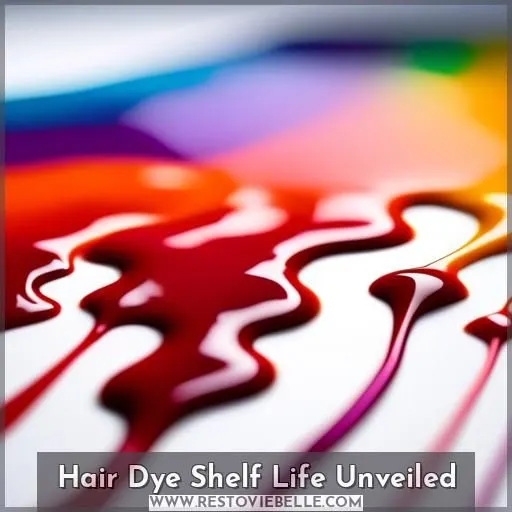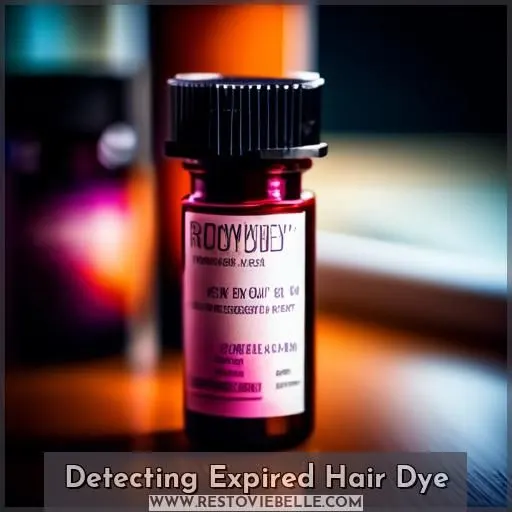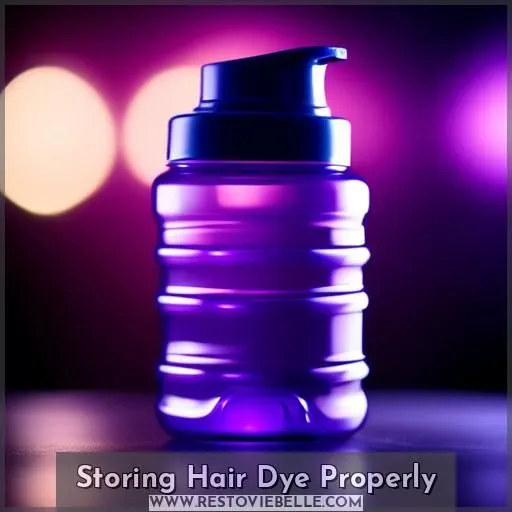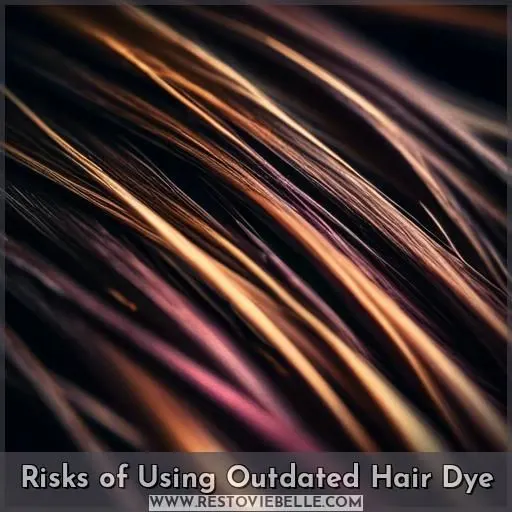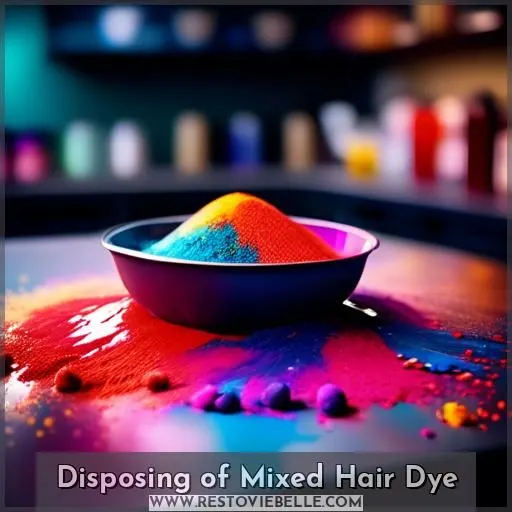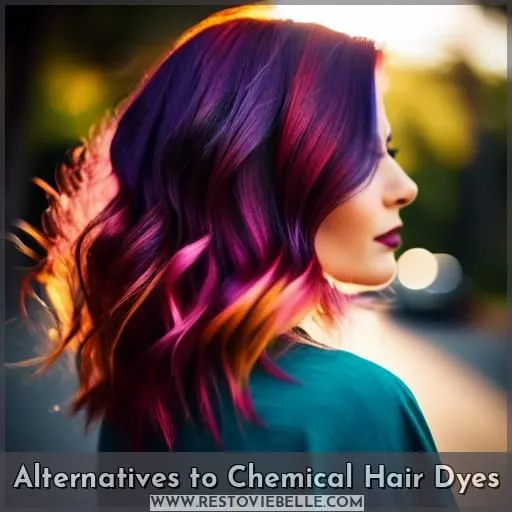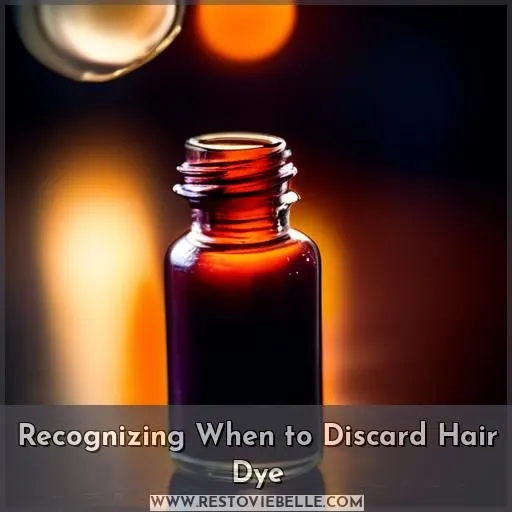This site is supported by our readers. We may earn a commission, at no cost to you, if you purchase through links.
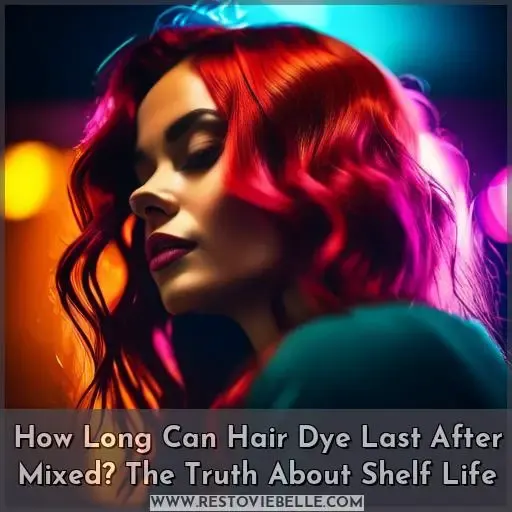
Mixed hair dye has a very limited shelf life of about one hour before it starts to degrade and become ineffective. You’ll want to apply the color immediately after combining the developer and tint for the best possible results.
Letting mixed dye sit too long can lead to uneven, dull coloring and potential hair damage. Signs it’s time to discard the mixture include changes in odor, texture, or color separation.
Want to avoid disappointment and guarantee vibrant, long-lasting color? Follow proper mixing and application timing to the letter – the secrets to hair dye success await.
Table Of Contents
Key Takeaways
- Hair dye mixed with developer has a very limited shelf life of about one hour before it starts to degrade and become ineffective.
- Signs of expired dye include changes in odor, texture, or color separation.
- Proper storage of hair dye involves keeping it in a cool, dry, and dark place, away from sunlight, heat, moisture, and humidity, and sealing it securely after use.
- Using expired hair dye can lead to negative effects, such as allergic reactions, skin sensitivity, impact on hair texture and color, potential hair cuticle damage, uneven coloring, and frizzy, weak hair.
How Long Can Hair Dye Last After Mixed?
Hair dye can last for different amounts of time after being mixed, depending on the specific product and conditions.
Some hair dyes have a shelf life of around 5 to 6 hours after being mixed and can’t be salvaged once the chemical reaction has occurred.
Other hair dyes, such as those from WECOLOUR, have a shelf life of twelve months after being opened. However, once mixed, they can’t be saved for another time.
It’s generally recommended to use hair dye as soon as possible after mixing to guarantee the best results.
Hair Dye Shelf Life Unveiled
Unopened hair dye can maintain its efficacy for up to three years when stored appropriately. However, once opened, the shelf life significantly diminishes to six to twelve months, and after mixing, the dye should be used within an hour for ideal outcomes.
Unopened Versus Opened Dye Longevity
Unopened hair dye has a shelf life of approximately 3 years.
While opened dye should be used within 6-12 months.
Manufacturer recommendations suggest that unopened hair dye doesn’t expire.
But after 3 years, it may not work effectively.
Old hair dye may cause unwanted side effects due to chemical imbalances, such as allergic reactions, skin sensitivity, and potential damage to hair texture and color.
The Critical Hour for Mixed Dye
After opening a hair dye container, the critical hour for mixed dye commences.
This is when the color begins to oxidize, and the longevity of the dye commences its decline.
During this period, the dye may exhibit signs of container discoloration, signifying that it’s approaching the end of its usable life.
It’s imperative to utilize the mixed dye within this critical hour to attain the desired color and avoid potential complications with the dye’s efficacy.
Detecting Expired Hair Dye
You’ll want to be on the lookout for a funky odor or changes in color and texture as these are tell-tale signs that your hair dye has expired. Additionally, inspect the packaging for any signs of tampering, ingredient separation, or an unusually dark color before mixing, which could indicate the dye’s chemical integrity has been compromised.
Odor and Color Changes
Regarding hair dye, the shelf life is a key element to think about for upholding the quality and safety of the product. Here are some essential points to remember:
- Unopened hair dye has a shelf life of about 3 years.
- Opened hair dye lasts for around 6-12 months.
- Mixed hair dye should be used within 1 hour.
- Signs of expired hair dye include a peculiar odor, changes in color or texture, separation of ingredients, an unusually dark color before mixing, and compromised or damaged packaging.
- Proper storage of hair dye involves keeping it in a cool, dry, dark place, away from sunlight, heat, moisture, and humidity, and sealing it securely after use.
- Using expired hair dye can lead to negative effects, such as allergic reactions, skin sensitivity, impact on hair texture and color, potential hair cuticle damage, uneven coloring, and frizzy, weak hair.
- Alternatives to traditional hair dyes include hair extensions, henna, hair chalk, hair mascara, and color-depositing shampoos and conditioners.
It’s vital to follow these guidelines to ensure the best results and minimize the risks associated with using expired hair dye.
Packaging and Chemical Integrity
Concerning the detection of outdated hair dye, several indications should be noted.
Firstly, inspect the packaging for any evidence of damage, such as tears or leaks.
If the dye’s color or texture has altered, it may indicate that it has deteriorated.
An unpleasant odor or the separation of ingredients can also be signs of expired dye.
If the dye has leaked or the container is cracked, it’s advisable to discard it.
Keep in mind that once the dye is mixed, it has a limited lifespan of just 1 hour.
Storing Hair Dye Properly
To maximize the shelf life of your hair dye, store it in a cool, dry, and dark environment, avoiding direct sunlight, excessive heat, and humidity. Properly sealing the container after each use and steering clear of bathroom storage are also vital steps to prevent contamination and premature expiration.
Ideal Conditions for Preservation
To extend your hair dye’s shelf life, stash it in a cool, dry, and shadowy nook.
Temperature control and low humidity levels are your allies against premature expiration.
Dodge light exposure like a bad hair day; it’s the nemesis of vibrant color.
Common Storage Mistakes
Avoid storing hair dye in the bathroom, where humidity and temperature fluctuations can affect its shelf life.
Leaking bottles are a sign of improper storage.
Over-application and excess dye cleanup can lead to wasted product and potential risks.
Dye application time and development time are critical factors in ensuring hair color consistency.
Organic and natural hair dyes have different storage requirements, so always follow the manufacturer’s guidelines.
Risks of Using Outdated Hair Dye
Using outdated hair dye puts you at risk of allergic reactions and skin sensitivity due to chemical degradation. It can also compromise your hair’s texture and vibrancy, leading to dull, uneven coloring or even damage to the cuticle.
Allergic Reactions and Skin Sensitivity
As you move from proper storage to use, consider the risks of expired hair dye. Allergy testing, such as patch testing, is essential to prevent skin irritation. Here’s what to bear in mind:
- Ingredient sensitivity can cause unforeseen allergic reactions.
- Consultation with a skin specialist is advisable if you’re susceptible to skin problems.
- Investigate alternatives to hair dye such as lemon juice or chamomile tea for a milder touch.
Compromised Hair Texture and Color
Using outdated hair dye can lead to compromised hair texture and color, resulting in uneven coloring, weak hair, and frizzy strands.
While there’s no evidence of direct hair follicle or shaft damage, the risk of allergic reactions and skin sensitivity increases.
To maintain healthy hair, it’s essential to store opened hair dye properly and discard mixed dye after an hour.
Consider alternatives like hair extensions, natural dyes, or temporary solutions like carrot juice or beet juice.
Disposing of Mixed Hair Dye
When disposing of mixed hair dye, you must consider the environmental impact. Opt for eco-friendly disposal methods, such as pouring the mixture into a sealable bag or container before discarding it in the trash to prevent contamination.
Environmental Considerations
As you consider the environmental impact of hair dye disposal, it’s important to be aware of the potential risks and sustainable alternatives. Hair dye products often contain chemicals that can harm the environment and water supply if disposed of improperly. To minimize waste and protect our planet, follow these guidelines:
- Check for local hazardous household waste disposal sites: Many communities have facilities that accept beauty products, including hair dye. This is the most environmentally friendly way to dispose of your used dye.
- Allow dye mixture to fully dry out before disposal: If no hazardous waste disposal is available, allow the dye mixture to dry completely before throwing it away.
- Avoid pouring dye down drains or toilets: Hair dye contains chemicals that can contaminate waterways and harm aquatic life.
- Air-dry excess dye on sheets of newspaper overnight before trashing: This helps to contain any residue and prevent staining.
- Recycle empty hair dye tubes and containers: Once the dye has been removed, recycle the packaging to reduce waste.
- Discard used gloves, applicators, and other tools in the trash, not recycling: These items shouldn’t be mixed with recyclable materials.
To further reduce waste, consider these tips:
- Get precise color measurements: Ask your stylist for exact ounce measurements to mix only what’s needed.
- Purchase single-use packets: Opt for single-dose dye packets instead of large containers whenever possible.
- Recruit a dye buddy: Split larger dye kits with a friend who colors hair the same shade.
- Save top portion for touch-ups: Only mix enough for your roots and save the remaining for later.
- Check dye levels before mixing: Don’t add full developer amount if you’ll have excess mixed dye.
- Use every last bit: Water down bowls and tools after applying to get out all remaining traces of dye.
Safe Disposal Methods
When discarding mixed hair dye, it’s essential to consider the environmental implications.
Proper packaging is crucial to prevent leaks and contamination.
Recycling options may be available for certain components, such as plastic containers.
For leftover dye, it’s advisable to follow local regulations or consult the manufacturer’s instructions.
Landfill disposal may be a viable option, but always ensure the dye is sealed and disposed of with household waste.
Alternatives to Chemical Hair Dyes
If you’re concerned about the potential risks of chemical hair dyes, it’s worth exploring natural and organic alternatives like henna, vegetable-based dyes, or temporary color solutions like hair chalk or color-depositing shampoos and conditioners. These options can provide a safer and more gentle approach to coloring your hair, especially if you have sensitive skin or prefer to avoid harsh chemicals.
Natural and Organic Options
Alternatives to Chemical Hair Dyes
When it comes to hair color, many people are seeking alternatives to traditional chemical dyes. Natural and organic hair coloring products offer a gentler approach to achieving your desired shade. Here are some options to contemplate:
Henna is a popular natural hair dye made from the leaves of the Lawsonia inermis plant. It provides a range of colors, from red to brown, and is often used as a temporary or semi-permanent dye. However, if you’re looking for a more permanent solution, consider other natural dyes that can be mixed with henna to create a wider range of colors.
Organic hair dyes are made from natural and organic ingredients, free from harsh chemicals like PPD, ammonia, peroxide, resorcinol, and metallic salts. These dyes are often certified organic and can be found in various shades, from light to dark. They’re suitable for those with allergies to harsh chemical products and can provide a more natural look.
Natural hair coloring products are made from plant-based ingredients, such as herbs and botanicals. These dyes can be found in various shades and are often free from harsh chemicals. They may not provide the same level of color intensity as traditional chemical dyes, but they can be a good option for those looking for a more natural alternative.
There are several home remedies that can be used to color hair, such as carrot juice, beet juice, coffee, and chamomile tea. These remedies can provide temporary color and are often more effective on light-colored hair. However, results may vary and it’s crucial to perform a strand test before applying these remedies to your entire head of hair.
For those looking for a quick and easy solution, temporary hair color options like hair chalk, hair mascara, and color-depositing shampoos and conditioners can be a good choice. These products provide temporary color and are often easy to apply and remove.
Temporary Hair Color Solutions
Ditch the commitment with temporary color solutions! Hair extensions let you flirt with length and hues without the breakup drama. Henna options offer a natural twist, painting your locks with earthy tones. Color-depositing products are the quick fix for a fleeting color fling, while hair chalk alternatives scribble fun into your style playbook. Embrace change, master your mane’s mood swings!
Recognizing When to Discard Hair Dye
You’ve likely heard the golden rule: discard any hair dye mixture after one hour. This critical timeframe prevents the chemical degradation that can lead to uneven coloring, excessive dryness, and potential allergic reactions. Stay vigilant for other warning signs, like an off-putting odor, color separation, or textural changes, which indicate the dye has expired and should be discarded immediately.
The One-Hour Rule After Mixing
After blending your hair dye, it’s vital to follow the one-hour rule. This means you should apply the dye within an hour of blending it. Here are some tips for ideal dye development and safe usage:
- Mixed dye stability: The dye mixture starts to break down after an hour, so it’s best to use it right away.
- Leftover dye usage: If you have any dye left over, throw it away safely to prevent bottle bursting or other dangers.
- Dye application timing: Apply the dye evenly and avoid putting too much on to prevent uneven coloring.
- Ideal dye development: The dye will develop over time, but using it within an hour guarantees the best results.
- Dye spillage prevention: Clean up any extra dye to prevent stains and possible skin irritation.
Signs of Dye Degradation
Recognizing when to discard hair dye is essential for maintaining the health of your hair and avoiding potential risks. Here are some signs of dye degradation to keep an eye out for:
- Ingredient separation: If you notice that the dye has separated into layers, it’s a clear sign that it’s time to chuck it out.
- Color or texture changes: If the dye has changed color or texture, or if it’s not producing the desired results, it’s likely past its prime.
- Funky odor: A foul smell can indicate contamination or spoilage, so trust your nose.
- Unusually dark color before mixing: If the dye is much darker than expected before mixing, it may have degraded.
- Tampered packaging: If the packaging looks damaged or tampered, don’t use the dye.
Conclusion
Timing is paramount in determining the duration of hair dye’s effectiveness after mixing.
The one-hour window requires undivided attention; exceeding it incurs the risk of inconsistent, lackluster coloration and possible hair deterioration.
Maintain vigilance for indicators of degradation, such as odor or texture alterations.
Appropriate storage and disposal methods further safeguard dye quality and protect the environment.
Adhere to these guidelines for vibrant, long-lasting outcomes every time.

